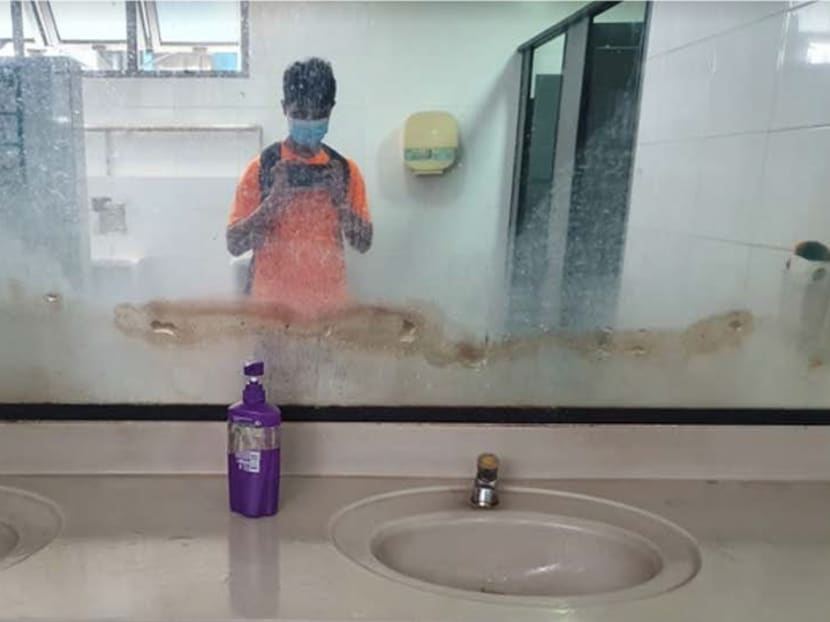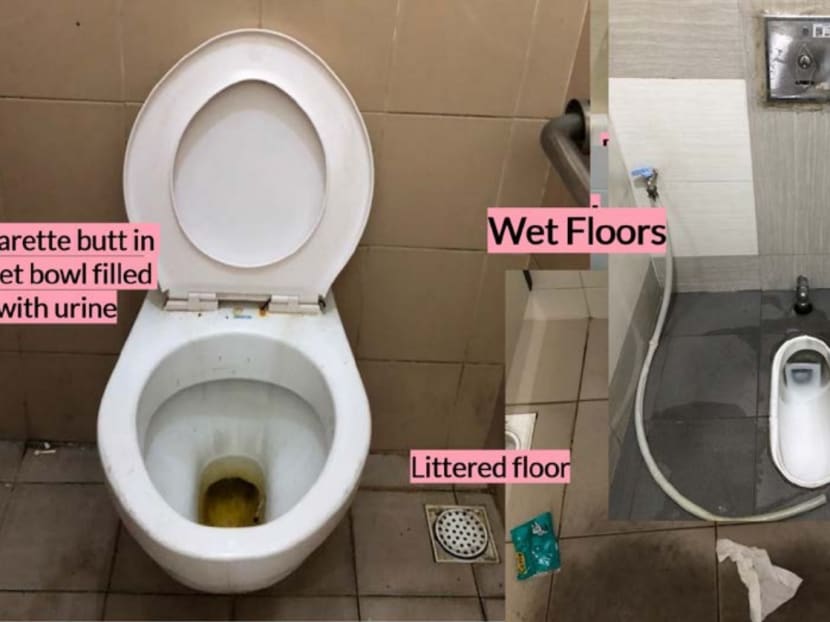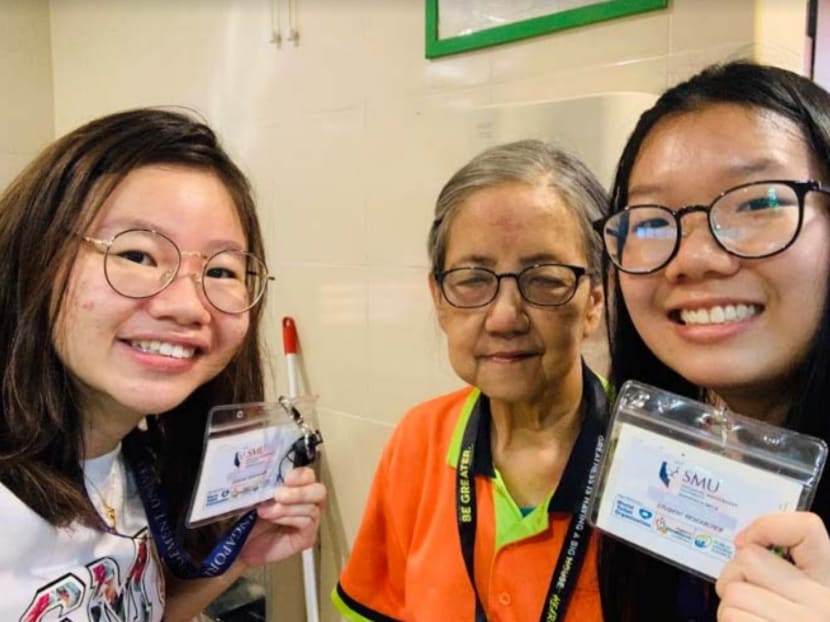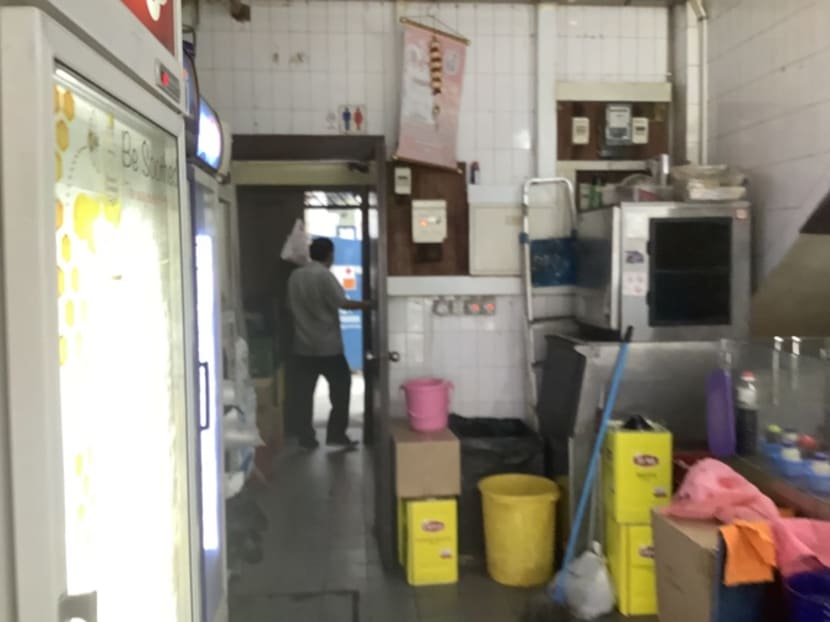Toilets at coffee shops, hawker centres have become dirtier since 2016: SMU study
SINGAPORE — The cleanliness of toilets at hawker centres and coffee shops has worsened in the last few years since 2016, and one in four patrons do not want to use these facilities at all if they have a choice.

Mirrors that were in need of cleaning or replacement at a public toilet that Singapore Management University students visited.
SINGAPORE — The cleanliness of toilets at hawker centres and coffee shops has worsened in the last few years since 2016, and one in four patrons do not want to use these facilities at all if they have a choice.
These are the findings of a nationwide survey named Project Waterloo published by the Singapore Management University (SMU) on Tuesday (May 26), based on a study by SMU senior lecturer of statistics Rosie Ching and 157 undergraduates.
They reported that there was a 11.4 per cent decline in the cleanliness index of hawker centre toilets from 2016 to early February this year, and coffee shop toilets have stayed dirty and largely unchanged over the same period. Observations from customers and evidence collected by the students also pointed to the general dismal state of these public toilets.
The dirtiest toilets were found in Tuas, Telok Blangah and Bukit Batok, while the cleanest were found in the Marina South area, followed by Tanglin and Changi.
Although the Covid-19 outbreak early this year cut short the fieldwork that students could conduct, they were still able to survey the public toilets at 104 out of 114 hawker centres and 1,181 out of 1,330 coffee shops.
More than three in five the respondents indicated that there was a need for moderate to a complete overhaul of cleanliness in such toilets.
Almost all (97 per cent) of the 2,269 coffee shop and hawker centre workers polled said that they used the toilets there, and more than half agreed that there was a need to improve the state of the toilets.
The study that was conducted between Jan 10 and Feb 7 of this year as part of the students’ SMU’s statistics course run by Ms Ching, was a follow-up to the first one done in 2016, both of which comprised on-site surveys of different aspects of the washroom environment such as sink and tap cleanliness.
These attributes were rated on a scale from one to five, with a rating of three indicating that the attributes were of “reasonable” standard.
These scores were then used to generate a Toilet Cleanliness Index for each toilet on a scale from zero to 100, with 100 being the cleanest.
Within this scale, toilets at coffee shops saw a small increase in the index, from 45.49 in 2016 to 46.35 in 2020.
While toilets at hawker centres were significantly cleaner than those at coffee shops, there was a drop in the cleanliness index from 65.73 in 2016 to 58.23 this year. The sharpest drop was in toilet bowl cleanliness, they found.
Ms Poh Xin Yi, an SMU undergraduate who helped to conduct the study, said that a common issue she came across was a lack of soap for washing hands.
“The onus is on the operators of such toilets to provide basic necessities such as proper soap dispenser and proper liquid soap and encouraging the cleaners to run through a daily check list to replenish such items,” she said.
Other nasty discoveries: Urine ponding in urinals, toilet bowls that were not flushed or filled with waste or cigarette butts, overflowing litter bins, litter on wet toilet floors, poor ventilation, and toilet cleaning schedules not used or updated at all.

This year, the students also interviewed more than 8,000 customers and workers about the state of toilets in coffee shops and food centres nationwide, an element that was previously absent from the 2016 survey.
More than a quarter of the almost 6,000 customers polled said that they were unwilling to use the toilets at coffee shops and hawker centres.
One customer interviewed in Punggol would only use one if it was “urgent” and another interviewed in Pasir Ris said that the stench of urine was “very, very strong” and there was no toilet paper or soap for washing hands.
Ms Ching said: “This was an intensely difficult and comprehensive survey of toilets and toilet users at hawker centres and coffee shops. Given Singapore’s reputation for progress and advancement, one would have expected the statistics to reveal the same for public toilet cleanliness.
“Although I personally harboured considerable doubt owing to the state of public toilets I had visited, it was still disheartening to see statistical analyses reveal a marked regression in toilet hygiene from 2016, and furthermore, in almost every single attribute of toilet cleanliness on average.”
Ms Ching believes that the decline in public toilet hygiene could be linked to the people who are unwilling to use the toilets even though they do not contribute to dirtying it.
“In a way, they are… concerned enough (about hygiene to) not want to use the toilet. But if they are so certain that they are not going to use the toilet, then they wouldn’t care as much about the (state) of the toilet,” she said.
Ms Ching believes that since the hygiene levels of toilets do not seem to affect the coffee shops and hawker centres that customers are willing to patronise, operators at these places do not feel the pressure to improve the hygiene standards of the toilets either.
However, for customers who do use the toilets, Ms Ching said that they have a role to play in keeping the toilets clean.
“There’s only so much (cleaners) can do if the public doesn’t practise civic mindedness in keep toilets clean,” she said.
In doing this study, she hopes that more people would become “aware of toilet hygiene as much as we are aware of Singapore being a food paradise”.
“My students and I hope that our collective work in surveying, data-collection and results will spur greater action towards improving our public toilet hygiene, especially now with the Covid-19 pandemic.
“We absolutely need to take greater care of the well-being of our toilet cleaners as well, given the daily conditions they face in tackling dirty toilets.”

Ms Ching hopes that more toilets at coffee shops and hawker centres will get certified by the Happy Toilet programme under the Restroom Association (Singapore) so that eventually, people will come to expect such certification from the public toilets that they visit.
The programme awards public toilets with three, four or five stars depending on the standards that the toilets meet.
The lecturer acknowledged that coffee-shop operators would have to bear some of the costs incurred in keeping toilets clean. At the moment, there is no incentive for these operators to spend money cleaning up toilets, so it may encourage them if there were subsidies given to direct such efforts.
Mr Jack Sim, the Singaporean founder and chief executive officer of the World Toilet Organisation, has been pushing since 2001 for greater awareness and action to improving toilet and sanitation conditions worldwide.
His advice to the public? Do not patronise coffee shops with dirty toilets. This could then motivate coffee shops to keep their toilets clean, he added.
“Remember that even if you don’t use these dirty toilets, the cooks who prepare your food are using them. If there is no soap to wash their hands, you may be eating their dirt (or faecal material),” he said.
The study also found that the closer toilets were to cooking facilities, the lower their cleanliness index.
Ms Ching said that this could be due to bins for dumping raw and leftover food being placed nearer to the toilets.
“These could attract pests if they are improperly kept and they could become smelly,” she said. “Overall, it makes for a very unhygienic situation.”

This year, Dr Teo Ho Pin, Mayor of North West District, is the patron of Project Waterloo, which is supported by the World Toilet Organisation, the Restroom Association (Singapore), the Public Hygiene Council and the Singapore Kindness Movement.
Dr Teo said in a media statement issued on the survey on Tuesday: “Ultimately, clean public toilets can only become a reality with the conscious efforts of users to keep them clean, which will complement robust design and maintenance guidelines.”
To raise the standards of public toilets, Dr Teo had previously launched the Clean Toilets @ North West initiative, proposing guidelines for toilets to keep them clean and elder-friendly.
These guidelines include having stainless steel gratings on the floor to prevent flooding as well as a proposed cleaning schedule for toilets to be cleaned five times a day during non-peak hours.






